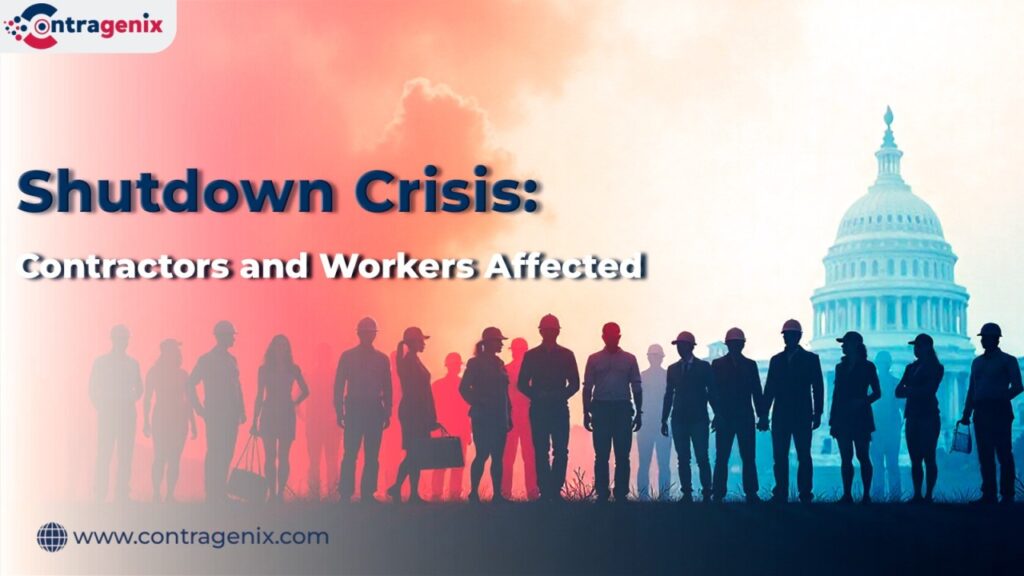Shutdown Crisis: Contractors and Workers Affected

Another government shutdown is here, bringing delays, confusion, and worry across the contracting world. News stories mostly talk about federal workers being furloughed, but contractors are deeply affected too. Contractors keep federal missions moving, and when funding stops, it quickly impacts projects, paychecks, families, and local communities.
Let’s break down what shutdown means for contractors and their employees, and share practical steps leaders can take to manage through the uncertainty.
The Immediate Impact on Contractors
When the government shuts down, contractors feel the effects quickly. It’s not just about missing payments it can pause projects, disrupt schedules, and create confusion around rules and requirements. Some of the biggest challenges include:
-
Contract Suspensions:With no funding, agencies may issue stop-work orders, forcing contractors to halt work.
-
Cash Flow Problems: Invoices can’t be paid, putting extra strain on finances—especially for small businesses with limited savings.
-
Uncertainty on Projects: Contractors aren’t sure when work will restart or if contract terms will change, making workforce and resource planning tough.
-
Employee Concerns: Unlike federal employees, contractor staff usually don’t get back pay. This puts pressure on retention, morale, and team stability.
As the White House has noted, shutdowns hurt vital services for families, veterans, and communities. For contractors, that impact is even heavier they must deal with stalled missions while also supporting their employees in the face of an uncertain funding climate.
Workers: The Human Side of the Shutdown
Behind every contract is a team of people engineers, IT experts, analysts, and support staff who keep federal missions moving. A shutdown impacts these workers in very real ways:
-
Lost Income:Many contractor employees don’t get paid during shutdowns, leaving families struggling to cover bills.
-
Cash Flow Problems:To save money, some companies reduce schedules or furlough staff, even though these workers had no role in the political stalemate.
-
Career Doubts:Skilled professionals in high-demand fields like cyber or AI may question whether staying in federal contracting is worth the risk.
-
Emotional Toll: Shutdowns damage morale and make employees feel caught in political crossfire, forcing contractors to work harder to keep trust and stability.
This people-focused side of the shutdown is rarely highlighted, but it often leaves the deepest impact. Companies that support employees during these difficult times can strengthen loyalty and resilience for the future.
The Contractor’s Dilemma: Balancing Mission and Business Survival
For leadership teams, shutdowns create a painful balancing act. On one hand, contractors want to keep teams engaged and ready to resume mission-critical work as soon as funding is restored. On the other, the financial realities of unpaid invoices and stalled projects can’t be ignored.
Key challenges include:
-
Pipeline Disruptions:Business development slows when agencies cannot issue new solicitations or awards.
-
Proposal Deadlines:Some solicitations freeze mid-process, leaving capture teams in limbo.
-
Indirect Costs:Even paused contracts accrue overhead office leases, IT systems, and insurance costs that don’t stop when work does.
-
Client Relationships: Shutdowns strain trust with agency customers, even though both sides are at the mercy of politics.
Leaders must weigh whether to absorb costs in the short-term to preserve capacity, or scale back to protect long-term financial health.
Strategies Contractors Can Use Now
While contractors can’t prevent shutdowns, they can prepare and respond in ways that minimize disruption. Some best practices include:
-
Scenario Planning:Develop clear contingency plans for contracts likely to be suspended. Identify which employees are most at risk of interruption and communicate expectations early.
-
Cash Flow Safeguards:Strengthen liquidity ahead of potential shutdowns. Access to credit lines or reserve funds can make the difference in sustaining payroll.
-
Communication with Employees:Transparency is critical. Even if the news is tough, workers value honesty over silence.
-
Engagement During Downtime: For employees on pause, consider professional development, internal training, or pipeline support tasks to maintain engagement.
-
Stay Close to Customers: Maintain open lines of communication with contracting officers. Knowing the latest status of your programs even if it’s “wait and see” helps with planning.
-
Policy Monitoring: Keep track of OMB guidance, agency contingency plans, and legislative updates to anticipate changes.
Long-Term Lessons: Building Resilience
Every shutdown reinforces a key truth: resilience in federal contracting requires planning for disruption. Contractors who treat shutdowns as temporary storms rather than once-in-a-decade surprises position themselves better for the future.
Some resilience-building strategies include:
-
Diversification of Clients and Portfolios:Reduce dependency on one agency or funding line.
-
Investment in Business Development:Maintain BD momentum during shutdowns to rebound faster once funding resumes.
-
Technology and Efficiency:Leverage digital tools, automation, and proposal support systems to do more with less when resources are constrained.
-
Employee Retention Culture:A supportive culture can keep employees loyal through uncertain times, even if short-term sacrifices are required.
Conclusion
Shutdowns are more than political standoffs in Washington; they are live crises for contractors and workers who keep the government’s mission alive. Families lose income. Small businesses face existential threats. Projects stalls that directly impact national security, public safety, healthcare, and innovation.
For contractors, the challenge is not only surviving the shutdown but leading with clarity, compassion, and strategy. By balancing business survival with workforce stability, contractors can emerge stronger and demonstrate the resilience that federal missions require..
At Contragenix, our role is to stand alongside contractors during times like these. We help businesses adapt strategies, stabilize pipelines, and prepare for the rebound once the funding spigot reopens. Shutdowns test our community, but they also highlight the indispensable role contractors play in sustaining the federal mission.
